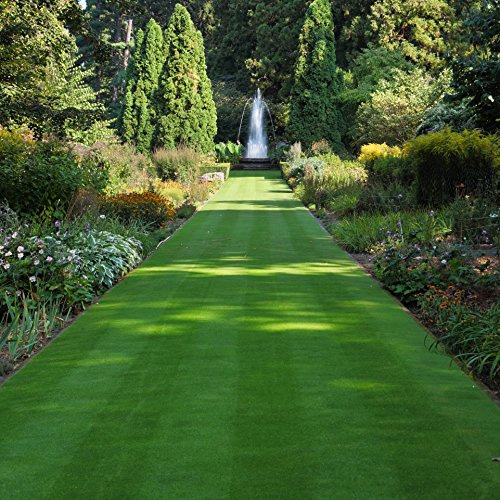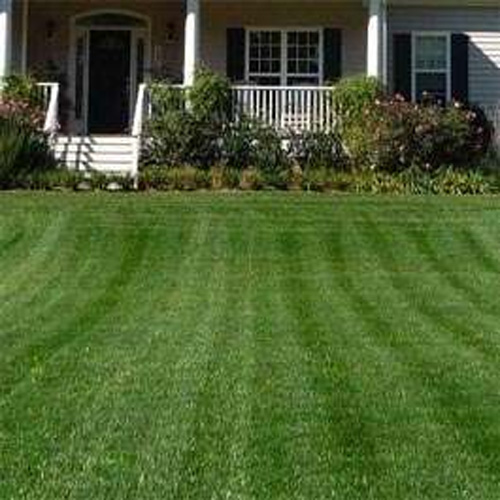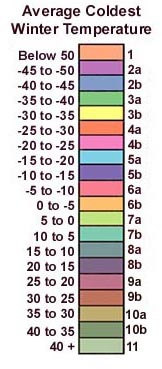
Legacy Fine Fescue
- Close-Mowing
- Lawns
- Resilient

Grasses used in Minnesota generally consist of bluegrass or bluegrass mixtures.
Kentucky Bluegrass
Kentucky bluegrass is the most widely used turfgrass in Minnesota. With proper management, it forms a long lasting lawn, and it is an aggressive sod former. Bluegrass grows rapidly during cool, moist weather, with slower growth during hot, dry weather. When rainfall is not adequate, watering is necessary to maintain high quality. All cultivars respond well to a mowing height of 1 ½ to 2 ½ inches.
Many cultivars of Kentucky bluegrass are available, and new selections are constantly being introduced. Cultivars may differ in color, disease resistance, vigor, and amount of care required for best performance. Unfortunately, no single cultivar provides ideal performance under every condition. Even disease resistance can change as new strains of diseases appear.
Fine-leafed Fescues
Fine-leafed fescues are cool season turfgrasses that are more tolerant of shade and infertile, droughty soils than Kentucky bluegrasses. The fine-leafed fescues are best adapted to dry, shady sites and will not tolerate wet, poorly drained soils. Compared to bluegrasses, fescues require minimal levels of management, including less fertilizer and water. Excessive fertilization or irrigation can cause a severe thinning of a fine-leafed fescue lawn. Leafspot diseases can also cause an extensive thinning of the lawn during midsummer. For these reasons, fine-leafed fescues are seldom grown alone, but are primarily used in mixtures with bluegrasses. Red fescue, chewings fescue and hard fescue are the three fine-leafed fescue species grown in Minnesota. Red fescue is a sod former, while chewings fescue and hard fescue are bunch-type grasses.
Perennial Ryegrasses
Perennial ryegrasses have an erect bunch-type growth habit with rapid seed germination and establishment. Medium levels of fertility and well-drained soils are preferred. Both common and improved perennial ryegrasses are available. Common or unimproved types tend to be short-lived, due to lack of winter hardiness. These common types also have a coarse appearance and a tough fibrous leaf with poor mowing quality. Improved cultivars developed for turf use have greater winter hardiness and better mowing characteristics. Only these improved cultivars should be considered for a lawn where rapid cover and wear tolerance are required. Ryegrasses may be seeded in combination with bluegrasses to establish a lawn on sloping areas where erosion is a potential problem.
Rough Bluegrass
Rough bluegrass forms a light green prostrate turf that is adapted to moist, shaded conditions. It is superior to Kentucky bluegrass in establishment vigor, but will not tolerate traffic or hot, dry conditions. It does not blend well with most turfgrasses, due to its light green color. Rough bluegrass is not recommended except for wet, shaded sites where fine-leaved fescues will not persist.
Turf Type, Tall Fescues
A new generation of finer textured, tall fescues has been introduced. These grasses have shown to be very wear and drought tolerant. Disease and insect problems have been minimal and performance on dry, sandy sites has been very good. They will also perform well in sun and shade. Winter hardiness seems adequate in southeast Minnesota, but hardiness in other areas is unknown. Tall fescues are bunch type grasses and should not be used for overseeding or mixed with other grass species. At this time, turf type, tall fescues should be used on a trial basis.
| Click Name To View Grass Seed Choice | Type | Applications | |
|---|---|---|---|
| Cool Season Mix - Showtime |
|
Cool Season |
Lawns - Full Sun to Moderate Shade Rye, Kentucky Bluegrass, Fine Fescue Mix |
| Cool Season Mix - Garland |
|
Cool Season |
Lawns - Full Sun to Moderate Shade Rye, Fine Fescue Mix |
| Fescue/Bluegrass Mix - Combat Extreme North |
|
Cool Season | Lawns - Wear Tolerant |
| Fescue Blend - Combat Extreme Transition |
|
Cool Season | Lawns - Wear Tolerant |
| Fine Fescue Blend - Legacy |
|
Cool Season | Lawns - Full Sun To Moderate Shade |
| Kentucky Bluegrass - Bluegrass Supreme |
|
Cool Season | Lawns - Golf Gourses - Full Sun |
| Kentucky Bluegrass - Midnight |
|
Cool Season | Lawns - Golf Courses - Full Sun |
| OSP Ryegrass |
|
Cool Season | Lawns - Golf Courses |
| Shade Grass - Poa Supina Mix |
|
Cool Season | Lawns - Full Sun - Deep Shade - Best Shade Grass |


Below is the USDA Zone Map for Minnesota so you can determine which zone you reside in. Below that are our picks for your state which will do best in your area. Next on this page are tables which list various grasses and their characteristics so you can compare before you decide on your purchase. Click on the product name (ie. Midnight) for more information about that grass and to make your purchase.
| USDA Zone Map For Minnesota | |
|---|---|
 |
 |
| Compare Various Grasses For Their Characteristics | ||||||||
|---|---|---|---|---|---|---|---|---|
| Cool Season Grasses |
Leaf Texture |
Establish Rate |
Nitrogen Use |
Water Use |
Drought Tolerance |
Salinity Tolerance |
Shade Tolerance |
|
| Bluegrass - Kentucky | Moderate to Fine |
Slow | Moderate to High |
Moderate to High |
Good | Moderate | Poor | |
| Bluegrass - Rough | Moderate to Fine |
Slow | Moderate to High |
Moderate to High |
Poor | Moderate | Excellent | |
| Fescue - Turf Type | Moderate to Coarse |
Moderate | Moderate to High |
Low to Moderate |
Excellent | Low | Good to Excellent |
|
| Ryegrass - Perennial | Fine to Moderate |
Very Fast | Moderate to High |
Moderate to High |
Good | Poor to Moderate |
Poor to Moderate |
|
| Compare Various Grasses For Their Characteristics - Continued | ||||||||
|---|---|---|---|---|---|---|---|---|
| Cool Season Grasses |
Fertility Needs |
Wear Resistance |
Mowing Height |
Cold Tolerance |
Acid Soil Tolerance |
Thatching Tendency |
Heat Tolerance |
|
| Bluegrass - Kentucky | Medium | Medium to High |
Medium | High | Medium | Medium | Medium | |
| Bluegrass - Rough | Medium | Medium | Medium | High | Medium | Medium | Medium | |
| Fescue - Turf Type | Low to Medium |
Medium to High |
Medium to High |
Medium | High | Low | High | |
| Ryegrass - Perennial | Medium | High | Low to Medium |
Medium | Medium | Low | Medium to High |
|